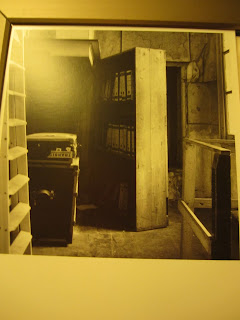



From August 8.
A common theme throughout Europe is the memory of World War II. I learned about the war through pages in my history textbook and listening to Grandpa Botica’s tank stories. But, many Europeans have only to step outside their door to walk the same streets Jews were forced to walk with yellow stars stuck to the front of their clothes. On August 8, I visited the “Anne Frank Huis” in Amsterdam. Today it is a museum, but from 1942-1944 it was the place in which Anne and her family hid from the Nazis. The building is sandwiched in a line of connected buildings that overlook one of Amsterdam’s many canals; it was also the location of Otto Frank’s business. From here, he sold a jelling agent used to make jam and seasonings for preparing meat.
The Frank family moved from Germany to the Netherlands in 1933, when Anne was four, because Hitler’s government had already begun discriminating against the Jews and her parents feared future life in Germany. In Holland, Otto Frank was able to provide for his family safely while Anne and her sister Margot were able to enjoy things like the beach and attending the school of their choice.
In 1940, when Anne was eleven, Hitler bombed Rotterdam, the Dutch army was overwhelmed, and the Netherlands became occupied by the German government. Here is an excerpt from Anne’s diary:
“After May 1940 the good times were few and far between: first there was the war, then the capitulation and then the arrival of the Germans, which is when the trouble started for the Jews. Our freedom was severely restricted by a series of anti-Jewish decrees: Jews were required to wear a yellow star; Jews were required to turn in their bicycles; Jews were forbidden to use trams; Jews were forbidden to ride in cars, even their own; Jews were required to do their shopping between 3.00 and 5.00 pm; Jews were forbidden to attend theatres, cinemas or any other forms of entertainment; Jews were forbidden to use swimming pools, tennis courts, hockey fields or any other athletic fields; Jews were forbidden to go rowing; Jews were forbidden to visit Christians in their homes; Jews were required to attend Jewish schools, etc. You couldn’t do this and you couldn’t do that, but life went on. (20 June 1942).”
In 1942, 16 year old Margot was “called-up” to work in Germany. Knowing this could only mean something terrible, her parents would not send her; it was time for the family to hide. The Franks and their closest friends had been preparing the annex of Otto’s business with furniture and food for some time. For two years, the family did not leave the building while Otto Frank’s business went on as usual signed over to his Christian partner. In an effort to remain undiscovered by the warehouse workers below, they blacked out the annex windows, tiptoed or stayed still all day long, and ran water as little as possible. Anne dealt with her feelings by confiding in “Kitty”, the diary she received on her 13th birthday. She passed the time by working on schoolwork her father provided her with, doing household chores, and writing stories. When I walked through her bedroom, I saw the pictures Anne glued to the wall to make it a more cheerful space. There were postcards of grassy hills and streams and trees, pictures of film stars and smiling children clipped from magazines, and a bright yellow poster advertising her father’s business. In the “living room” area, I saw pencil marks on the wall where her dad measured how tall Anne and her sister were growing. I climbed the steep wooden staircase to the attic where Anne went to be alone. Through the window you could see a chestnut tree and the blue sky.
In August of 1944, the police raided the building. The swinging bookcase that so cleverly hid the entrance to the annex failed to protect and the family was discovered. To this day no one knows who tipped off the police. The Franks were first sent to a transit camp called Westerbork where the women broke open batteries for work. Shortly after that, they were crammed like sardines into a “goods” train and sent to Auschwitz. The Frank family was lucky because in the initial sorting of Jews, they were chosen to work instead of being sent to an immediate death in the gas chamber. Anne, Margot, and their mother hauled stones while their father dug a ditch. Anne and Margot were eventually shipped off to another camp, Bergen-Belsen. In March of 1945, both Anne and her sister contracted Typhus which had been spread by the lice that infested their clothing and bodies. It did not take them long to die, Margot first, then Anne the next day; she was 15. One month later, their camp was liberated by British soldiers.
Of the eight Jews who hid in the annex, Otto Frank was the only one who survived. Shortly before their hiding place was raided, Anne heard someone on the radio encourage the people of Holland to document their experiences. This inspired her to rewrite every page of her diary in the hope that she could publish it after the war - making her story known. One of the family's close friends managed to find Anne’s diary right after the raid. She held onto it and gave it to Otto when he returned to Amsterdam. He had it published in 1947.
Pictures were not allowed inside the museum, so I took pictures of the postcards I bought (shhhh). They are of: Anne’s room, the moveable bookcase leading into the annex, the outside of the building (look for the blacked out windows), a window that wasn’t blacked out that Anne was allowed to look through.

Grandma (and I) really enjoyed this, especially the reference to Grandpa's tank reports! This is fascinating, although sobering. Such creative photography:-) xoxox
ReplyDelete